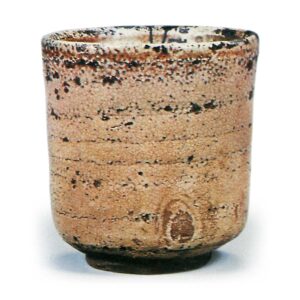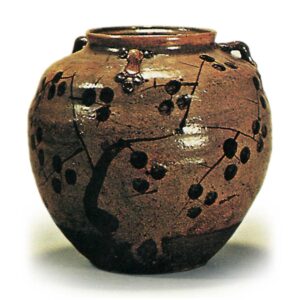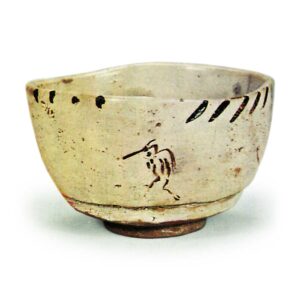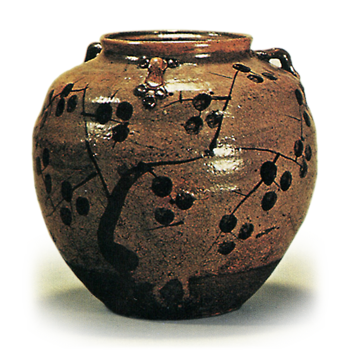


Karatsuyaki is a pottery produced in Hizen Province (Saga Prefecture).
According to legend, the origin of Karatsuyaki dates back to about 1,700 years ago. When Empress Jingu conquered the three Koreas, she took the princes of the three Koreas as hostages and settled them in Kusano Township in Hizen Province (Saga Prefecture), where Takeuchi Sukune named the three princes Koryo Kojirokaja, Silla Tarokaja, and Baekje Toheikaja. Today, the names of the three princes are known as Kojukanja (Nashikawachi, Karatsu City) where Kojiro-kanshi was placed, Dara (Dara, Karatsu City) where Tarokanshi was placed, and Fujihira (Fujihira, Genkai-cho, Higashimatsuura-gun) where Fujihira-kanshi was placed. Kojiro Kanjiro made pottery at his residence and presented it to Empress Jingu. This is said to be the origin of Karatsu ware. Later, during the reign of Emperor Saimei (655-61), a kiln was built at the foot of the Karatsu Bay and large tea bowls were produced using the Korean pottery method. These were all unglazed ceramics. They are still frequently excavated in the vicinity of Karatsu. The name “Karatsu” is said to have come about because of the large number of vessels from Korea, Tang China, and Annan that came to the Matsuura County coast during the reign of Emperor Seiwa (858-76), and the area became a focal point for the arrival and departure of Tang ships. He built and settled at Kajiya Castle in Mikuri-no (Mikuri-cho), Matsuura County, Hizen Province.
Hata Genjiro Mochi, the third son of Hisa’s sixth grandson Genkiyo, built Kishimi Castle in 1245 (Kangen 3) at Onikotake, Karatsu City, Saga Prefecture, and became the founder of the Hata family. From this time onward, the Hata family’s power grew so great that they imported foreign civilizations, and not only did the castle prosper, but the year-end market on Onikotake was attended by people from all over Kyushu, who came to spend the night. During the Wonhyung period (1321~4), the Iidong kiln was established in the mountains west of Onjidake with a transparent glaze of the northern Korean style, and the Hozutama kiln with an opaque sea squirt white glaze was started next. In later years, the Iidongjanggama and Onjogak Saraya kilns were established, and the Donoyadani, Hiramatsu, and Otani kilns were opened at the foot of the southwestern mountains, with the Kojugansha kiln located 12 km northwest of this site. The products included jars, tokugi, kataguchi, suribachi, deep bowls, pots, plates, bowls, and tea utensils. Ekaratsu was started in the middle of the Edo period and developed greatly by 1594. In April 1592, Toyotomi Hideyoshi invoked the Joseon War, and in 1594, he confiscated the Hata family because of his infatuation with the wife of Hata Mikawa Morichika, who had been in love with him. As a result, Onikotake’s kilns were closed and the potters fled to various places. The remains of the Iidora pottery kiln, which was founded by Onikotake, still remains in Ayuki, Hobashira, Karatsu City, and is a split bamboo climbing kiln. The potters who escaped from Onikotake went east to establish the Yamase Kamigama and Shimogama kilns (Yamase, Hamatama-cho, Hamadama-cho, Hamadama-gun), fled west to establish the Hazetani kiln in Minamihata Village (Minamihata-cho, Imari City), and established the Hayayama kiln in the Hirado domain Mikawachi (Mikawachi, Sasaebo-City, Nagasaki Prefecture).
After the Bunroku era, Terasawa Shimamori Hirotaka took over the former domain of Hata Mikawa Morichika, and around 1603, potters of the Hata family were given preferential treatment, and those who had fled to other places started kilns one after another in the Karatsu domain. Many pottery kilns were established around the same time during the Keicho period (1596-1615), including the Okawahara kiln in Minami Hata Village, the Tashiro kiln, the Yakiyama upper and lower kilns, the Yanotani kiln, and the Umenosaka kiln in Okawa Village (Okawa-cho, Imari City), the Yamazaki kiln in Wakagi Village (Wakagi Town, Takeo City), the Douen kiln, the Aboya upper and lower kilns, the Fujikawauchi kiln, the Kaneishihara upper and lower kilns in Matsuura Village (Matsuura-cho, Imari City), and others. In 1616, when the Shiinomine Kiln was opened in Minamihata Village, all the potters of the aforementioned Karatsu domain gathered at Shiinomine, and Korean potters who came to Japan after the Bunroku and Keicho Wars joined the group. Karatsu ware enjoyed its heyday. However, in 1700 (Genroku 13), the Shiinomine kiln, which had been so prosperous, suffered a public crisis due to the inconvenience of kiln firing, and all but a few potters were forced to leave the kiln. This is the so-called Shiinomine landslide. Many of the potters who left Shiinomine went to other mountains in Hizen, while others opened pottery kilns in the Karatsu territory. These include the Hirayama Kamihigashi and Uratani kilns in Ochi Village (Ochi Town, Karatsu City), the Nakayama kiln in Hatatsu Village (Hatatsu Town, Imari City), the Tanaka kiln in Kitahata Village (Higashimatsuura County), and the Hatajima kiln in Onizuka Village (Onizuka, Karatsu City). Later, during the Kyoho period (1716-36), the Tachikawa, Katakusa, Sajiro, and Zentoku kilns were opened in Okawa Village. During the Kan’ei era (1624-44), Nakazato Moemon of Shiinomine established a cedar forest kiln in Mikawachi in the Hirado domain. This kiln was later used by the Matsuura family for pottery. During the Keian era (1648-52), Umemura Wabei built the Hirayamakami Imperial Kiln in Aichi-village using workers from Shiinomine by order of Okubo Kagamori Tadatomi, feudal lord of Karatsu, and in 1707, Nakazato Tarouemon V from Shiinomine built the Kiraiboshicho Imperial Kiln at Nishi-nohama (Nishi-hama-cho, Karatsu City) by order of Doi Suomori Toshimasu, feudal lord of Karatsu, In 1804, he moved the imperial kiln to Machida Karajinmachi (Machida, Karatsu City) and called it the Ochawan Kiln, and continued to produce Karatsu ware for the feudal lords Doi, Mizuno, and Ogasawara until 1873 (Meiji 6). After the abolition of the domain kilns, the 11th generation Nakazato Yutaro Tensuke devoted himself to the improvement of Karatsu ware, and the 12th generation Sohaku went into retirement, but is still alive and well, and is now the 13th generation Nakazato Tarouemon of the Ochawan Kiln.
In the Chugoku region and westward, “yakimono” is called “karatsu-mono” and has become a synonym for ceramics and porcelain.
This piece came from the Onjidake Iidong Kiln, Iidong Jangjo Kiln, and Kojukansha Kiln. This is a blue-yellow glazed bowl or dish with distortions due to firing damage, and was so named because it was used to weigh rice. It is believed to have been made during the Yuan-Heng period (1321-4).
Mian [ne-nuki]: This is believed to have been made between the Kemmu period (1334-8) and the Bunmei period (1469-87). Some have suggested that it is a tea bowl with green glaze and rough clay produced at the Iidong Janggama and Iidong Jangjo Kama kilns in Onjidake, but there are other theories. The origin of the name means “so old that the roots fall out.
Seto Karatsu] This type of karatsu is said to have been made between Onin (1467-9) and Tensho period (1573-92). It is so named because it closely resembles the glaze of Owari Seto. Many of the bowls and plates have extremely large cracks in the glaze.
Joseon karatsu] This type was produced between the Tensho period (1573-92) and the Kan’ei period (1624-44). It is said to have been so named because the clay and glaze were imported from Korea, but it is entirely made in Karatsu. It is mainly produced at the Fujikawauchi, Onikotake Hobashira, Saraya, and Donoyadani kilns. It has a black ame glaze with an opaque sea squirt white glaze, and the clay is rough and iron-rich. It is mostly used for water jars, plates, and bowls, and rarely for tea bowls. The Okawahara Kiln in Minamihata Village and the Nijuhayasan Kiln in Mikawachi, Oriose Village (Mikawachi Town, Sasebo City) during the Keicho era (1596-1615), and the Afodani upper and lower kilns, Fujinokawachi Kiln, Kaneishiwara Hirotani Kiln, Kaneishiwara upper and lower kilns in Matsuura Village, which were decorated with opaque sea squirt white glaze, can be called Korean karatsu. Of these, only the Okawara kiln appears to have the same clay as that of Onikotake, but the clay of the other kilns is smaller and tighter.
E Karatsu] This type of karatsu began in the middle of the Onikotake period and was made by applying a blue-black glaze and painting iron on it. In the later years of Onikotake’s reign, Iido-kami-gama kilns also had paintings with iron brush over the top using stencils. Also, there are iron paintings in a blue-black or blue-yellow glaze with no luster from the Douen kiln, the Afodani upper and lower kilns, the Fujikawauchi kiln, the Yama upper and lower kilns, and the Onoya-no-Tani kiln, which were built during the Keicho era (1596-1615), and the Nomine Uemura kiln, built during the Genwa and Kanei era (1615-1644). The clay is clayey and dusty, and the firing rate is a little lower than that of the Omiya-no-Tani and Shii-nomine-Uemura kilns. Products include large bowls, medium bowls, plates, tea bowls, boar’s mouths, tea utensils, etc. [Okukoryo] Made by the Yamase Kamigama and Shimogama kilns, this piece is made of pure white clay with an opaque sea squirt white glaze. This term is also used for wares fired in this kiln that do not have a sea squirt white glaze, but have a blueish-yellow color with a transparent glaze. There is another theory. See the section on “Okukoryo.
Dugout karatsu: Pottery that was thrown into the ground after being fired in the aforementioned kilns during the Keicho Genna Kanei period (1596-1644) and then dug out and prized by later generations. These are also referred to as complete pieces of the same type.
The clay is white with a thick white glaze and many ice cracks.
The most well-known of these bowls were made during the reigns of Okubo, Matsudaira, Doi, and Mizuno, the lords of the Karatsu Castle. The most well-known example is a large tea bowl made by order of the Ogasawara lords during the Ansei period (1854-60), inlaid with a cloud and crane pattern in iron, glazed in loquat color, with a white clay bowl and a higher-than-normal height on the base.



